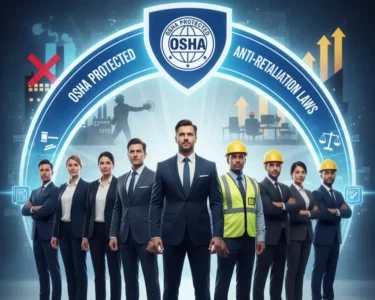The Occupational Safety and Health Administration (OSHA) protects workers who report unsafe, unlawful, or unethical workplace conditions.
Under its Whistleblower Protection Program, OSHA enforces more than 20 federal laws that shield employees from retaliation, ensuring that no worker is punished for speaking up about safety risks, health violations, or illegal activities.
According to the U.S. Department of Labor, OSHA handled over 3,300 whistleblower complaints in 2023, covering industries from construction and energy to healthcare and finance (DOL Whistleblower Annual Report 2023).
These protections make it possible for employees to report workplace hazards and misconduct without fear of termination, demotion, or discrimination.
What Is OSHA Whistleblower Protection?
The Whistleblower Protection Program ensures that workers are legally protected when reporting violations that threaten public safety or break federal law.
Retaliation can include:
-
Firing, demotion, or reduction in pay
-
Harassment, intimidation, or threats
-
Denial of promotion or reassignment
-
Suspension or disciplinary action
OSHA’s whistleblower protection covers a wide range of industries, including construction, manufacturing, energy, transportation, and healthcare.
Federal Laws Protected by OSHA
OSHA enforces the whistleblower provisions of over 20 federal statutes, such as:
-
Occupational Safety and Health Act (OSH Act): Covers workers reporting workplace hazards and unsafe conditions.
-
Surface Transportation Assistance Act (STAA): Protects commercial drivers who report unsafe practices.
-
Sarbanes-Oxley Act (SOX): Protects employees who report financial and shareholder fraud.
-
Pipeline Safety Improvement Act (PSIA): Protects those reporting unsafe pipeline operations.
-
Energy Reorganization Act (ERA): Covers employees reporting nuclear safety concerns.
-
Clean Air Act (CAA), Safe Drinking Water Act (SDWA), Federal Water Pollution Control Act (FWPCA), and Toxic Substances Control Act (TSCA): Protect environmental whistleblowers.
-
Consumer Product Safety Improvement Act (CPSIA): Protects individuals reporting unsafe consumer goods.
-
Wendell H. Ford Aviation Investment and Reform Act (AIR21): Covers whistleblowers in aviation safety.
For a full list, visit the OSHA Whistleblower Statutes Page.
How the Whistleblower Protection Process Works
Step 1: Filing a Complaint
Employees must file a whistleblower complaint within 30 days of any retaliatory action.
Complaints can be filed:
-
By mail or fax: Send to your nearest OSHA Area Office
-
In person: Visit any local OSHA office
The filing date is based on when OSHA receives the complaint.
Step 2: OSHA Investigation
Once received, OSHA will:
-
Verify the complaint was filed on time
-
Determine if it falls under one of the protected statutes
-
Investigate evidence of retaliation or unsafe practices
-
Interview both the employee and the employer
-
Attempt mediation or settlement when possible
Step 3: Remedies and Outcomes
If OSHA determines retaliation occurred, the employer may be ordered to:
-
Reinstate the employee
-
Pay back wages and compensatory damages
-
Remove any negative personnel records
-
Reimburse attorney or legal fees
If no retaliation is found, the case may be dismissed. However, employees can appeal to the Department of Labor’s Administrative Law Judges for a hearing (DOL Appeals Process).
Limitations Under Section 11(c)
Section 11(c) of the OSH Act gives employees the right to file a retaliation complaint, but does not allow private lawsuits.
Instead, OSHA investigates on behalf of the employee. If OSHA declines to act, the worker cannot independently sue under this law, though other federal statutes may allow private legal action.
How to Stay Protected as a Whistleblower
Workers can protect themselves by:
-
Keeping records of all safety reports or retaliation evidence
-
Reporting violations quickly (within the 30-day deadline)
-
Filing complaints only through official OSHA channels
-
Completing OSHA-authorized training to better understand their rights
Training programs such as the OSHA 10-Hour and 30-Hour Courses help workers recognize retaliation, identify unsafe conditions, and report violations responsibly.
👉 Enroll in OSHA Courses training Online to learn how to recognize hazards, file complaints, and protect your rights under federal law.

Conclusion
OSHA’s Whistleblower Protection Program is a cornerstone of worker safety and integrity.
It empowers employees to report hazards, fraud, and unsafe conditions, all while being protected from retaliation.
By understanding these rights and completing OSHA training, workers and employers alike can build safer, more compliant workplaces that uphold transparency and trust.











